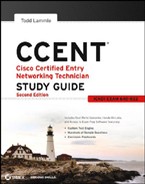Chapter 1
Internetworking
THE CCENT EXAM OBJECTIVES COVERED IN THIS CHAPTER INCLUDE THE FOLLOWING:
- Describe the operation of data networks
- Describe the purpose and functions of various network devices
- Select the components required to meet a given network specification
- Use the OSI and TCP/IP models and their associated protocols to explain how data flows in a network
- Describe common networking applications including web applications
- Describe the purpose and basic operation of the protocols in the OSI and TCP models
- Describe the components required for network and Internet communications
- Identify and correct common network problems at layers 1, 2, 3 and 7 using a layered model approach
- Implement a small switched network
- Select the appropriate media, cables, ports, and connectors to connect switches to other network devices and hosts
- Explain the technology and media access control method for Ethernet technologies
- Explain network segmentation and basic traffic management concepts
- Identify, prescribe, and resolve common switched network media issues, configuration issues, autonegotiation, and switch hardware failures
 Welcome to the exciting world of internetworking. This first chapter will really help you understand the basics of internetworking by focusing on how to connect networks using Cisco routers and switches. First, you need to know exactly what an internetwork is, right? You create an internetwork when you connect two or more networks to a router and configure a logical network addressing scheme with a protocol, such as IP on the router interfaces. I'll be covering these four topics in this chapter:
Welcome to the exciting world of internetworking. This first chapter will really help you understand the basics of internetworking by focusing on how to connect networks using Cisco routers and switches. First, you need to know exactly what an internetwork is, right? You create an internetwork when you connect two or more networks to a router and configure a logical network addressing scheme with a protocol, such as IP on the router interfaces. I'll be covering these four topics in this chapter:
- Internetworking basics
- Network segmentation
- How bridges, switches, and routers are used to physically segment a network
- How routers are employed to create an internetwork
I'm also going to dissect the Open Systems Interconnection (OSI) model and describe each part in detail because you really need a good grasp of OSI for a solid foundation to build your networking knowledge upon. The OSI model has seven hierarchical layers that were developed to enable networks to communicate reliably between disparate systems. Since this book centers on all things CCENT, it's crucial for you to understand the OSI model as Cisco sees it, so that's how I'll be presenting the seven layers to you.
Since there are a bunch of different types of devices specified in the different layers of the OSI model, it's also very important to understand the many types of cables and connectors used for connecting all those devices to a network. I'll go over cabling Cisco devices, discussing how to connect to a router or switch (along with Ethernet LAN technologies) and even how to connect a router or switch with a console connection.
After you finish reading this chapter, take the time to answer the review questions and complete the written labs. These are given to you to really lock the information from this chapter into your memory. Don't skip them!
 To find up-to-the-minute updates for this chapter, please see www.lammle.com/forum and/or www.sybex.com/go/ccent2e.
To find up-to-the-minute updates for this chapter, please see www.lammle.com/forum and/or www.sybex.com/go/ccent2e.
